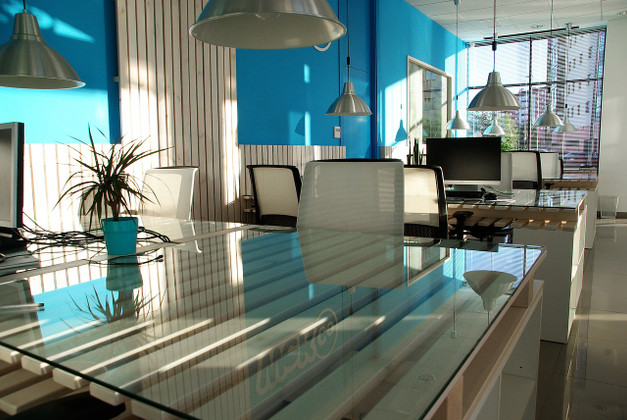The Power of Colour: How Office Decor Influences Productivity
Posted by The Urban Hyve Team on 10th Apr 2024
The design and aesthetics of an office space play a pivotal role in shaping the work environment. Among the various elements that contribute to an inviting and productive workspace, colour stands out as a powerful influencer. The strategic use of colour in office decor goes beyond mere aesthetics; it has a profound impact on the mood, creativity, and productivity of those within the space. In this article, we delve into the power of colour and explore how the right colour palette can significantly enhance workplace productivity.
Understanding the Psychology of Colour
Colour has a psychological as well as emotional impact that goes beyond mere visual appeal. Different colours evoke different emotions and responses, and therefore harnessing this knowledge is key to creating an office environment that fosters productivity.
1. Blue: Calm and Productivity
Blue is a calming and serene colour that promotes a sense of tranquillity. It is associated with increased focus and productivity, thus making it an excellent choice for offices where concentration is crucial.
2. Green: Balance and Renewal
Green is often linked to nature, symbolising growth and renewal. It has a balancing effect, reducing stress and promoting a sense of harmony. Incorporating green into office decor can enhance overall well-being.
3. Yellow: Energy and Positivity
Yellow is known for its energising and uplifting qualities. It stimulates creativity and positivity, making it suitable for areas where brainstorming and innovation are encouraged.
Opera Modern Fabric Tub Chair - Black / Red
4. Red: Passion and Dynamism
Red is a bold and attention-grabbing colour associated with passion and energy. While too much red can be overwhelming, strategic use can evoke a sense of urgency and drive.
5. Neutral Tones (Grey, Beige, White): Versatility and Simplicity
Neutral tones provide a versatile backdrop, allowing other colours to pop. They also convey a sense of simplicity and sophistication, contributing to a clean and organised environment.
Applying Colour Psychology to Office Decor
1. Accent Walls: Strategic Focal Points
Introduce colour through accent walls. Choose a colour that aligns with the mood you want to create. For example, a calming blue in meeting rooms or collaborative spaces can enhance focus.
2. Furniture and Accessories: Pops of Productivity
Incorporate colour through furniture and accessories. Vibrant chairs, artwork, or decorative items can inject energy into the workspace and break the monotony of neutral tones.
Miko Stylish Tub Chair - Fabric
3. Branding Colours: Consistency and Identity
Align office decor with your brand colours. Consistency in branding fosters a sense of identity as well as purpose among employees and visitors.
4. Personalised Workspaces: Empowering Individuality
Allow employees to personalise their workspaces with colours of their choice within a predefined palette. This not only contributes to a positive work environment but also empowers individuality.
5. Nature-Inspired Themes: Bringing the Outdoors In
Incorporate nature-inspired themes with a variety of greens and also earth tones. This not only connects employees with the outdoors but also promotes a sense of calm and balance.
Practical Considerations in Using Colour
1. Consider Lighting: Natural and Artificial
The interplay between natural as well as artificial lighting can influence how colours appear. Consider this when selecting a colour scheme to ensure consistency.
2. Company Culture: Reflecting Values
Align the chosen colours with the values as well as culture of the company. For example, a creative agency might embrace vibrant and unconventional colours, while a law firm may prefer more subdued tones.
3. Balance and Contrast: Harmonising Elements
Achieve balance by combining bold as well as neutral colours. Contrast can draw attention to specific areas, such as focal points or collaborative spaces.
Measuring the Impact
Assessing the impact of colour on productivity involves observation, employee feedback, and also performance metrics. Regularly evaluate the mood as well as atmosphere of the workspace to make informed adjustments.
In Conclusion
The power of colour in office decor is undeniable. By understanding the psychological impact of different colours and strategically incorporating them into the workspace, you can create an environment that enhances productivity, fosters creativity, and contributes to the overall well-being of employees. Whether through accent walls, furniture, or personalised workspaces, colour has the potential to transform a mundane office into an inspiring and dynamic space. As you embark on the journey of optimising your office decor, remember that the right colours have the ability to empower your workforce and elevate the success of your business.













